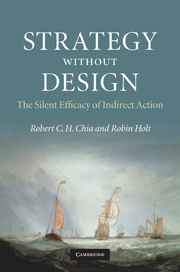Book contents
- Frontmatter
- Contents
- Preface
- Introduction
- 1 Spontaneous order: the roots of strategy emergence
- 2 Economic agency and steps to ecological awareness
- 3 Reconceptualizing agency, self-interest and purposive action
- 4 The ‘practice turn’ in strategy research
- 5 Building and dwelling: two ways of understanding strategy
- 6 Strategy as ‘wayfinding’
- 7 The silent efficacy of indirect action
- Epilogue: Negative capability
- Notes
- Index
7 - The silent efficacy of indirect action
Published online by Cambridge University Press: 22 January 2010
- Frontmatter
- Contents
- Preface
- Introduction
- 1 Spontaneous order: the roots of strategy emergence
- 2 Economic agency and steps to ecological awareness
- 3 Reconceptualizing agency, self-interest and purposive action
- 4 The ‘practice turn’ in strategy research
- 5 Building and dwelling: two ways of understanding strategy
- 6 Strategy as ‘wayfinding’
- 7 The silent efficacy of indirect action
- Epilogue: Negative capability
- Notes
- Index
Summary
The history of strategy is, fundamentally, a record of the application and evolution of the indirect approach… The indirect approach is as fundamental to the realm of politics as it is to the realm of sex.
Basil Liddell-Hart, Strategy: The Indirect Approach, pp.xix–xxIn the last chapter we argued that wayfinding provided a different and almost counter-intuitive take on what it means to act strategically. The underlying spirit of wayfinding is a sense of the positivity of incompleteness: one is under way, and in being under way the ends of one's actions emerge as one goes along. We only know as we go. Contrary to the navigational mindset, this openness and absence is not something to lament or correct; indeed, it is not a limitation at all, but a part-expression of our natural condition of dwelling that has steadily been hidden from us as we have become more and more technologically advanced. As the examples of Graeme Obree and Google show, the existence of an as yet indefinable space (something that is yet to be ordered technologically) constitutes a realm of potentiality that allows wayfinders to establish an authentic imprint on unfolding situations and, in so doing, to unexpectedly effect a dramatic change in the course of events through their ingenuity and local coping actions.
In this chapter, we return to our initial observation that somehow, paradoxically, it is these locally initiated spontaneous responses, the ad hoc ‘making dos’, that often, surprisingly, generate longer-term sustainable outcomes than more deliberate and direct forms of intervention.
- Type
- Chapter
- Information
- Strategy without DesignThe Silent Efficacy of Indirect Action, pp. 186 - 208Publisher: Cambridge University PressPrint publication year: 2009



